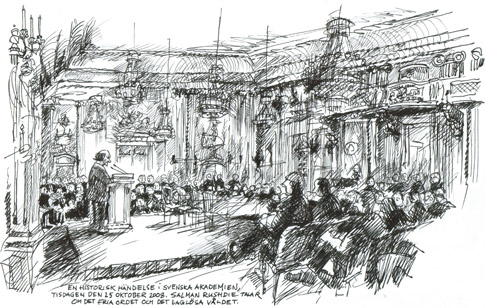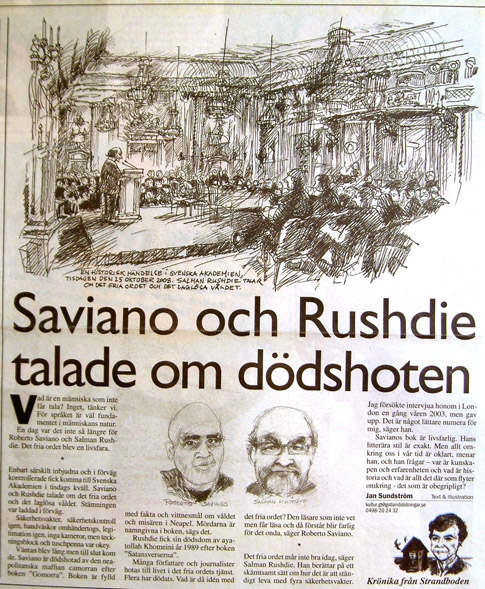Jan Sundström has worked for 40 years as a director and producer at The Swedish Television Company (SVT). He did all kinds of productions – from art documentaries to multi-camera productions for sports events to entertainments. After his retirement he replaced the camera with the pen and started a column in a local Swedish newspaper where he writes each fortnight about nearly everything. The speciality of this column is that the author always submits drawings to illustrate his articles instead of the usual photos. After 15 years of publishing this series, he is rather sceptical about the effect of graphic journalism in the surroundings of an ordinary newspaper. He wonders if these drawings, when they appear in an area which consists of nearly 99 percent photos, are really conceived as journalistic documents or not rather as irrelevant “curiosities” or “antiquities”. He asks himself why drawings are commonly judged as being “fine”, whereas photos are evaluated as being “good”. Here are some of his deliberations and experiences:
When I started to work in film and television, in the late 1960s, most people were not reluctant to act and talk in front of the camera. People rather liked to be present in newspapers or on television. Celebrities at that time did not hesitate to agree on being filmed or photographed. But in the late 1970s, this situation started to change for several reasons. Publicly well-known persons started to ask for the purpose of being photographed. At that time, we met more and more rules and restrictions to be followed in pictorial publications. During the 1980s it became common that photographers and reporters in most professional situations had to identify themselves and also reveal the purpose and intentions . At present the Swedish parliament is debating and considering new boundaries and limitations for the publication of pictures of all kind. Such considerations among politicians and legislators are now also common in several other countries.
I always enjoyed drawing. That is maybe the only truthful confession I can make about my graphic intentions. It started when I was very young. I went to The Royal University College of Art in Stockholm at the age of just only seventeen. It was all about drawing.
During my entire career as a director in film and television, I always used drawings as notes in hand on locations, in proposals for sceneries, at rehearsals and during actual recordings. Whether it was a documentary filming or multi-camera recording inside a studio or the positioning of twelve cameras on a mountain slope in a world cup downhill ski-race – drawing has been a useful tool to express my intentions to others.
Up to about fifty years ago, and earlier, reportage drawings and illustrations were in common use in most daily newspapers. Today, drawings are rare and often deemed a kind of curiosity in journalism. Photography has taken over all together and I would say that 90 percent, or more, of all pictures in newspapers, and in media in general, are photos. I have worked with live photography more than many others, so one cannot say that I have anything against photos – but to me a reportage-drawing in a newspaper seems to be much more demanding for the reader and therefore more interesting than most photos nowadays.
During the last fifteen years, as a spare-time commitment, I have written a column every fortnight for a local daily newspaper here in Sweden. My column is about almost everything I find meaningful to comment on. It could be politics, current affaires, sports, media, literature and art. The speciality with my column is that I am always expected to submit one or a few drawings on the subject of my text. This is a kind of signum for my column and writing.

Gotlands Tidningar (website: https://www.helagotland.se/ )

Masthead of Jan Sundström´s fortnight column in Gotlands Tidningar. The vignette shows a little cabin located on a remote position at the most northeastern point of the island Fårö, north of the larger island Gotland, in the Baltic Sea, where Sundström sometimes draws and writes in reclusiveness.
Alexander Roob of the Melton Prior Institute asked me to describe a few examples where I have used drawings in my column and where a photo would have been out of the question. Here are the examples I have chosen.
The first case is a column from 2008 on the Pop Art movement. For that I used materials from a meeting with Andy Warhol in his The Factory in New York in 1981 and also from another interview with the composer John Cage, ten years later in 1991. My text refers to the influence John Cage´s work apparently had on Warhol. I came to The Factory with a film crew for one day of documentary filming. During the usual briefings concerning the purpose of the filming and it´s legal circumstances, it turned out that no separate press photos of Andy Warhol were allowed during that session. Instead, I followed my usual habit of drawing on whatever small piece of paper I had at hand and made portraits of Warhol during the actual filming. No one in his staff objected to the scribbling in my pad. Warhol was moving around all the time, so my drawings had to be made very quickly. For the article I used one of my old pencil drawings which I felt gave my column a much more personal touch

Jan Sundström, Andy Warhol, New York, June 1981 (pencil on laid paper, 15 x 21 cm)

Jan Sundström, John Cage, New York 1991 (pencil on laid paper, 15 x 21 cm)
In November 2006, I met Queen Silvia of Sweden over a cup of coffee in the The Artists Club in Stockholm. The meeting was informal. For years it had occurred to me that this remarkable woman had, in a way, saved the existence of the Royal family in Sweden and that without her support her husband would not have survived on the throne.
So we talked about her mission in that intimate atmosphere surrounded by 19th century paintings. I was sure that if I would have picked up a camera, the Queen would have held that for an insult and our meeting would have stopped at that point. But to scribble in my small pad while talking with her was, as I would say, to her liking. In such an informal situation, the Queen made a rather young girlish impression – quite in contrast to her official appearances In the finished drawing in my column I wanted her to look like that young woman over a cup of coffee – without making a caricature of her.

Jan Sundström, Queen Silvia of Sweden Stockholm November 2006 (Fountain pen, ink and watercolours on laid paper, 21 x 30 cm)
In the autumn of 2008, it was announced that the author Salman Rushdie would give a lecture at The Swedish Academy on how it is to live under the death threat of the so-called “fatwa” declared by the ayatollahs. The speech was to be held in front of a large audience of literary celebrities and a few selected representatives from the media. The whole arrangement was surrounded by severe security precautions. Before entering that 18th-century hall at The Academy everyone was body-searched by hand and by scanners. Any suspicious items and especially cameras were strictly forbidden. In an application which I had made beforehand, my pens and my pad had been accepted and the security guards helped me to find a good position for my purpose. In the waiting time before Rushdie´s, performance I managed to draw the scenery and left out a space in the centre of where the lecturer would stand. During his half-hour I managed to keep Rushdie’s small-size gestalt in that 18th-century hall. After Rushdie had left, the security guards came over and looked carefully at my drawing. They apparently liked it and said that they were surprised how I could have done it in such a remarkably short time. In a situation like that, one feels good about being a draughtsman and a journalist at the same time.

Jan Sundström, Salman Rushdie, Stockholm November 2008 (fountain pen, ink on laid paper, 21 x 30 cm)

When I revisited The Swedish Academy to report on last year’s Nobel Prize winner Mo Yan, the security precautions were almost as strict as in Rushdie´s case. Before the speech, I was allowed to walk around in the premises with my pen and pad and I was treated by the Academy and the security men as “special” – as that journalist who makes drawings, as they said. They offered me a special seat right in front of the lecturer. Again cameras were strictly forbidden and again the security men treated me kindly and confessed that they could not believe how I could finish such a drawing in only half an hour – if they would not have witnessed it with their own eyes.

Jan Sundström, Mo Yan, Stockholm, December 2012 (dip-pen, India ink and watercolours on laid paper, 21 x 30 cm)

Jan Sundström, Alice Munro, Stockholm, December 2013 (Chalk, wash and watercolour,15 x 21 cm) – Alice Munro wasn’t able to come personally to the Nobel Prize ceremony. So the drawing had to be made from Munro´s live appearance on a large video screen inside The Academy hall)
I have been reflecting on this little anecdote a lot. Is it a positive or a negative sign or even a kind of forecast for a future level of existence of drawing as a medium that these honourable security men, with their special qualification for keen observation, disliked photographers, as they said, but on the other hand were so fond of my tiny drawing? These questions are not meant to be answered by simply stating that drawing is superior to photography. I rather think that this incident points to a certain dilemma on behalf of drawings ….
